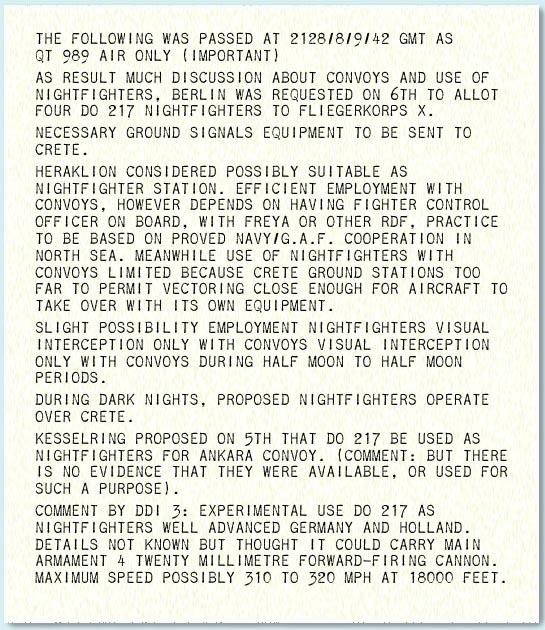NOTE: This warning that a night fighter could not intercept with just “its own equipment” was backed up by a later British comparison of Lichtenstein with AI Mk. VII:
The range is halved to a maximum of [3.2 km]. The range at 45º dead ahead is less than [1.6 km] … There are definite indications that [Lichtenstein] has been developed to bridge the gap between the performance of the Giant Würzburg in vectoring the fighter to its target and the maximum visual range from the fighter. Its capabilities as an instrument of freelance interception are limited …
|
On 25 September 1942, RAF Middle East notified G/C Colin Cadell of Signals Intelligence that the previous day, two Do 217 of 7./NJG 2 had been identified arriving in Heraklion, one of these being R4+DR; it seems that this information had come from VHF traffic. Two days later, XII. Fliegerkorps (which commanded home defence night fighters) asked X. Fl.Kps. to:
… take immediate measures to secure the special apparatus (L(Roman)I apparatus with aerial) built in the Do 217 of the Night Fighter Detachment which crashed in Eleusis with Ofw. Dingeldei.
It was noted at Bletchley Park that: “L 1 has appeared several times in accounts of night fighting on the Western Front … where it clearly stood for Lichtenstein”. Later it was ascertained that a Do 217 (surely the same one) under repair in the Eleusis workshops was marked D5+NM, and in Cadell’s evaluation:
It belonged originally to second Gruppe NJG 3, Schleswig. Not known whether any more Do 217 night fighters have been or will be drawn from this unit.
|



